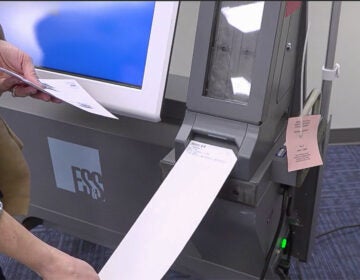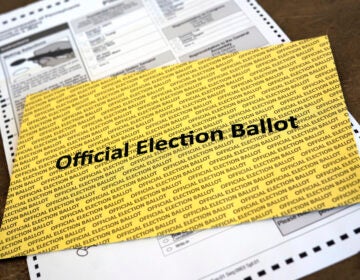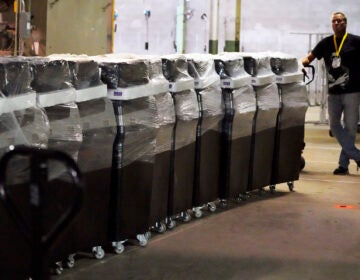N.J. sees progress in test of paper-trail voting machines that allow audit of results
A review of midterm election offers assurance that electronic vote counts are reliable, but lawmakers show limited interest in deploying the technology statewide.

(Election Systems & Software)
New Jersey’s first pilot tests of voting machines that provide a way to verify results proved successful in the last election, and now some officials are looking forward to expanding testing later. Typically, elections with state Assembly seats topping the ticket — like this coming fall — have low turnouts and so make this an ideal time to roll out new machines.
These machines include a paper ballot alongside an electronic screen which both allows voters to check that their choices were properly marked and keeps a paper trail for the elections board. Fewer people casting ballots should help reduce the wait some may experience as voters who may be confused by the new technology take more time on the machine.
But it’s unclear how quickly New Jersey may move to join the vast majority of states that require all voting machines to have a voter-verified paper trail. The state is using only a portion of a $10 million federal grant to fund the small-scale pilots in Union, Gloucester and Essex counties. And several bills that would push New Jersey closer to what outside groups consider the safest voting machines continue to flounder in the Legislature.
County and state officials were pleased, however, with New Jersey’s small step, after they conducted post-election reviews that included audits to ensure voters’ choices were counted properly.
Trudi Gilfillian, a spokeswoman for Secretary of State Tahesha Way, said the goal of the pilots in Westfield, National Park and some of the voting districts in Montclair “is to introduce state and local officials to the terms and concepts of risk-limiting audits and understand how the process might work with the voting equipment being considered for purchase in New Jersey.”
The counties examined a random sample of voted paper ballots against the electronic machine counts to ensure the correct candidates were declared winners; in this case, the U.S. Senate contest was the race audited.
‘So far, so good’
“I was expecting it to be 1 or 2 off, but the numbers matched perfectly,” said Stephanie Salvatore, superintendent of elections in Gloucester County, of the audit of votes cast in National Park, a small borough on the Delaware River. She said that, in addition to the state’s partial audit, her office oversaw essentially a recount of all ballots cast last year. “So far, so good.”
Similarly, Nicole DiRado, administrator of the Union County Board of Elections, said the audit of results in Westfield went well: “The machines read the ballots accurately.”
Election Day did not go quite as smoothly, with long lines developing at times in locations where the new technology was in place. There were a number of reasons.
For one thing, many voters took longer than usual using the machines because they were unfamiliar with the way the system worked — despite a broad education and outreach campaign that included in-person and online tutorials on using the equipment. This was exacerbated by the efforts of some poll workers to go overboard in explaining to voters how to use the machines, which held up the lines at times and wound up confusing some voters, DiRado said.
There were also problems with the equipment that DiRado thinks will be solved by tweaking the process. When a voter signed in, he was handed the paper ballot that he would have to insert into the machine to record his votes. It rained heavily at times on Election Day, and some of these ballots got wet or crinkled as people waiting on line held them for several minutes or longer. This led to paper jams as some voters tried to insert their ballots into the machines.
And then there was the unexpectedly large turnout. More than 15,000 people, or about two-thirds of those registered, went to the polls in Westfield — roughly twice as many as voted in the 2014 midterm election.
“We did have some growing pains on Election Day,” DiRado said. “We learned some important lessons. But the machines did what they were supposed to: they counted the votes accurately … Most people loved the new machine, more than anything, they loved seeing their votes recorded properly.”
Planning to build on the successes
She said the county plans to refine its processes during special elections and continue to add new machines. The county initially spent $1.9 million for 190 machines and other equipment and expects to spend as much as $4.8 million in total, when it implements the new system countywide. The goal is to have the entire county using paper-verified balloting for the 2020 presidential election.
“Theoretically, we would like to have them in all the districts by the end of the year, so we will be ready for 2020,” DiRado said.
Gloucester County is moving more cautiously. The county spent about $100,000 on 10 machines and plans to continue testing these in special elections — the first one is a school election on January 22 — to get additional feedback. Just about 1,000 people used the paper-trail system in National Park on Election Day.
“The people just seemed to really like the machine,” Salvatore said. “Before we lay out millions, we want to make sure … The more special elections we have, the more feedback we can get.”
Salvatore’s ultimate goal, like DiRado’s, is to also switch all of the county over to auditable machines in time for the next presidential election.
Lack of movement in Trenton
At the moment, election officials’ goals are all that are driving the effort to make New Jersey’s election system more secure. While some lawmakers are trying to get the counties to update decades-old voting equipment, the Legislature as a whole is moving at a snail’s pace.
Of several pending bills, only A-3991 has cleared a committee hurdle and currently awaits further action by the Assembly Appropriations Committee. It requires only that counties that replace their voting machines must acquire a system that includes a paper trail and it does not mandate that the state pay for such upgrades.
S-1113, which would require all counties to switch to an optical-scan voting system with a paper trail and oblige the state to pick up the tab, has not even had a hearing in the 10 years it has been pending in some form. In 2016, without a hearing, it received a fiscal estimate from the nonpartisan Office of Legislative Services, which put the initial cost at $100 million for 11,245 new machines at $5,750 apiece and other related costs.
That’s far more than the current estimate of between $40 million and $63.5 million by the Brennan Center for Justice at New York University. Both the Brennan Center and the Center for American Progress have urged New Jersey to adopt auditable voting machines. New Jersey is one of only five states where nearly every machine has no paper trail with which to audit or verify electronically counted results. State officials say that because New Jersey voting machines are not connected to the internet, they are safe from hacking.
The notable exception is Warren County; it uses the Avante Vote-Trakker, which combines a touch screen with a paper ballot. The county’s experience with these machines over several years gives state officials and legislators more background in determining how to move forward to ensure no one can tamper with individuals’ votes.
If the off-year election this year is similar to 2015, the last time the Assembly topped the balloting, fewer than a quarter of those registered will vote. That would mean a turnout of about 1.2 million. Implementing a new system that some voters will find confusing would be preferable with a lower turnout, officials say.
Last year’s midterms brought 3.2 million to the polls, while close to 4 million cast ballots in the 2016 presidential election.
WHYY is your source for fact-based, in-depth journalism and information. As a nonprofit organization, we rely on financial support from readers like you. Please give today.




